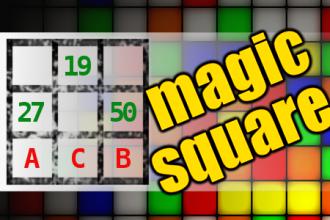MAGIC SQUARE: Calculate A-B*C
The aim is to place the some numbers from the list (19, 21, 26, 27, 28, 29, 34, 50, 52, 58) into the empty squares and squares marked with A, B an C. Sum of each row and column should be equal. All the numbers of the magic square must be different. Find values for A, B, and C. Solution is A-B*C.Correct answers: 1
#brainteasers #math #magicsquare

A family is at the dinner tabl...
A family is at the dinner table. The son asks his father, "Dad, how many kinds of boobies are there?
The father, surprised, answers, "Well, son, there's three kinds of breasts. In her twenties, a women's breasts are like melons, round and firm. In her thirties to forties, they are like pears, still nice but hanging a bit. After fifty, they are like onions."
"Onions?"
"Yes, you see them and they make you cry."
This infuriated his wife and daughter so the daughter said, "Mum, how many kinds of 'willies' are there?"
The mother, surprised, smiles and answers, "Well dear, a man goes through three phases. In his twenties, his willy is like an oak tree, mighty and hard. In his thirties and forties, it is a birch, flexible but reliable. After his fifties, it is like a Christmas tree."
"A Christmas tree?"
"Yes, dead from the root up and the balls are for decoration only."
The father, surprised, answers, "Well, son, there's three kinds of breasts. In her twenties, a women's breasts are like melons, round and firm. In her thirties to forties, they are like pears, still nice but hanging a bit. After fifty, they are like onions."
"Onions?"
"Yes, you see them and they make you cry."
This infuriated his wife and daughter so the daughter said, "Mum, how many kinds of 'willies' are there?"
The mother, surprised, smiles and answers, "Well dear, a man goes through three phases. In his twenties, his willy is like an oak tree, mighty and hard. In his thirties and forties, it is a birch, flexible but reliable. After his fifties, it is like a Christmas tree."
"A Christmas tree?"
"Yes, dead from the root up and the balls are for decoration only."

